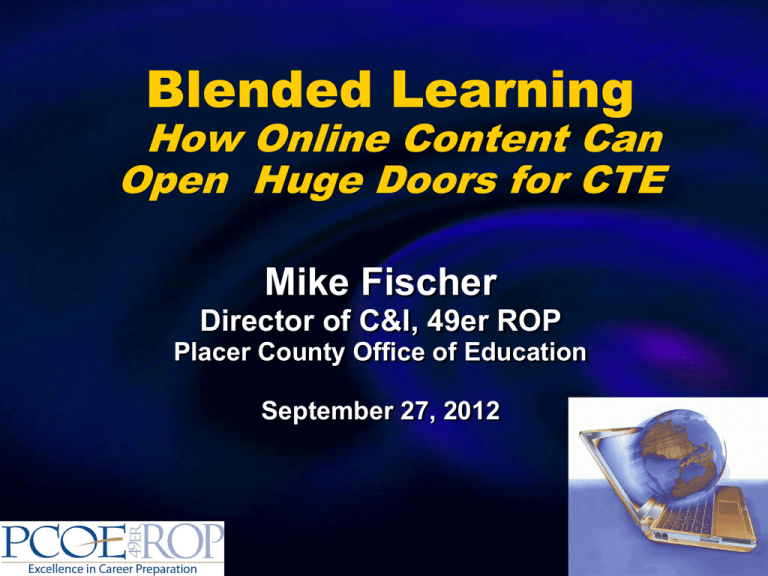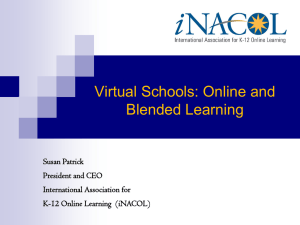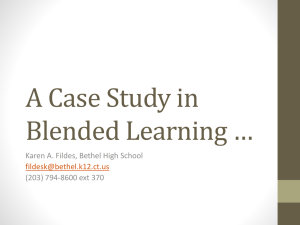Blended Learning Presentation
advertisement

Blended Learning How Online Content Can Open Huge Doors for CTE Mike Fischer Director of C&I, 49er ROP Placer County Office of Education September 27, 2012 Overview of Topics: 1. 2. 3. 4. 5. 6. 7. 8. Welcome Overview of Blended Learning Tour of a Sample Course Online Agencies and Resources Courses at 49er ROP / PCOE Content Management Systems Pros & Cons, Successes & Challenges Next Steps, things for ROC/Ps to consider What is “blended learning?” Mix of traditional instruction and web-based instruction “On ground” + “Online” “Face to face” + “Cyberspace” Online materials delivered through a learning management system (LMS) –Blackboard, Moodle, Schoology, Desire to Learn “Blended” model differs from fully online classes Blended Model: – Students attend class AND go online – Online materials enhance face-to-face instruction – Tends to be more “synchronous” “100% Online” Model: – No class meetings – All online, no face-toface instruction – Course may be “synchronous” or “asynchronous” How learning happens Students access materials online through LMS –Presentations, links to web articles, graphics/media, videos, discussion boards –Assessments: quizzes and tests given online –Both formative and summative Exams Online? Really? Options: –Can fix time window –Can limit duration of test –Can scramble answers –Can prevent backtracking –Can use lockdown browser* *Disallows other websites Tech allows new options to address “collaboration” Instructor’s Role ROP instructors post materials and monitor activity online –Create assessments –Respond to student inquiries –Moderate student discussion boards –Post class announcements Student’s Role To learn! –Attend class one day per week in community classroom courses –Complete online reading –Submit assignments online, take quizzes –Participate in discussion boards In blended model, online materials don’t replace onground teaching, they enhance it. Who creates and uploads the course materials? Often created by instructor – Most texts come with some electronic materials – Many instructors have wealth of e-materials they created Can purchase “course cartridge” – Check with textbook publishers for compatibility AND tech support provided Critical Role: The System Administrator Certain outcomes: – There will be technical issues – There will be a learning curve for all – Teachers, students, tech experts – Sys Admin will have to solve tech problems so teachers can teach – Will likely train teachers – Will troubleshoot problems with uploading materials – Helpdesk for students and teachers is essential Video Tour of a Blended Course Agencies and Resources: CCSESA e-Learning Framework iNacol Leading Edge Certification CCSESA e-Learning Framework: 4 Focus Areas: –Content: What course outcomes are desired? –Teaching: What are best practices for blended instruction? –Technology: Which LMS, at what cost? What about equitable user access? –Operations: How will students be supported? Fast Facts About Online Learning: –40 states have virtual schools or initiatives –1.8M enrollments in K-12 districts nationwide (2009-10), 74% of which were HS –Highest enrollments are credit recovery and dual-credit –92% of students accessing courses from school, 78% accessing from home Top Policy Issues: –Enable accountability through competencybased learning –Develop new assessments – Both formative and summative –Research and document best online practices –Professional development is critical –Ensure accessibility for all students “Technology doesn’t teach students, effective instruction does.” –6 week certificate program for online educators –Builds active online participation skills –Develops connection tips with online students –Encourages ethical, safe, and legal online behavior in both educators and students –Supported by iNACOL and CTAP –Cost: $450 per participant Blended Courses at 49er ROP Recently developed ROP courses: Web 2.0 / Open Source Communications Advanced Placement Computer Science* Product Marketing* Game Development (Microsoft X-Box programming) Traditional ROP courses that are now “blended:” Clinical Medical Assisting 12% of sections are blended Another 40% have digital Dental Careers content online Veterinary Science* *UC approved courses Learning Management Systems (LMS) LMS Pros: Cons: Blackboard • Robust LMS • Industry Standard* • Decent tech support • Expensive • Not especially intuitive Moodle • Free! • Growing in popularity • Some tech help available online • Need tech expertise in open source Schoology • Very affordable • Looks like Facebook • Unproven, but promising Successes! Able to serve students in new delivery model Learning is more student-centered rather than teacher-centered Allows flexibility for students and teachers – Critical for a large regional program – Overcomes barriers of space and time Develops 21st Century Skills in students New collaboration among veteran teachers Rich dialogues about new instructional practices Challenges… Not all students stay in touch online Connection with student harder to establish 100% online class requires low commitment from students (and limited success) Intervention is more difficult online Technical issues with LMS Technical issues with content from publishers Different pedagogy (Leading Edge Certification) Opportunity Knocks: Flex funding has created a unique opportunity for ROC/Ps – Without affecting schools’ ADA funding, ROPs can offer online courses schools may not be able to – Regional programs draw students from multiple schools and provide adequate numbers for full sections – ROPs can attract students who may otherwise go to 100% online schools (save ADA for schools) Next Steps for ROC/Ps and Blended Learning Next Steps: 1. Continue to pilot new courses and new approaches 2. Explore and refine LMS solutions for blended model 3. Develop best practices for blended instructors 4. Continue to provide professional development for all teachers (some of it online!) Questions? mfischer@placercoe.k12.ca.us Thank you!











